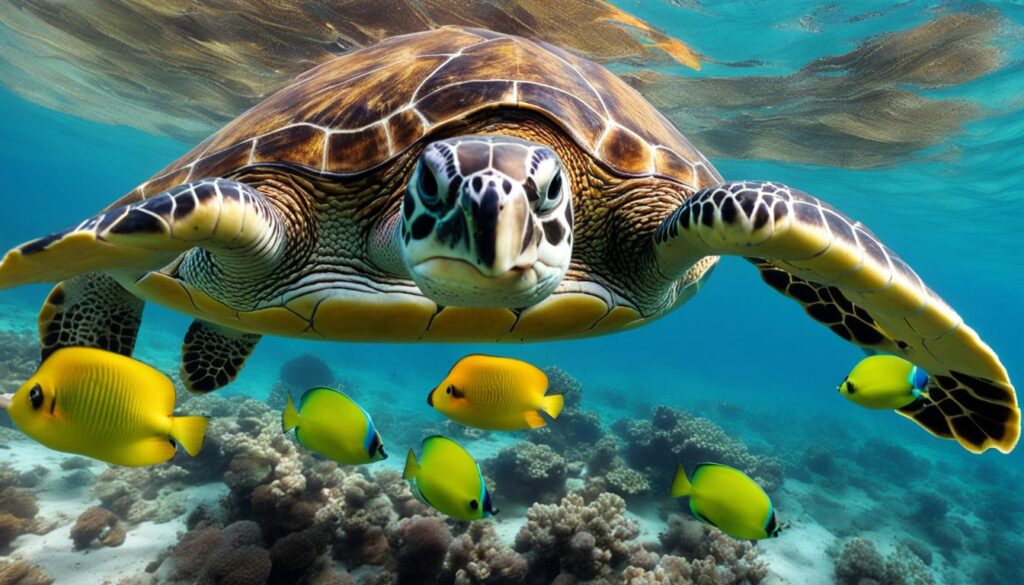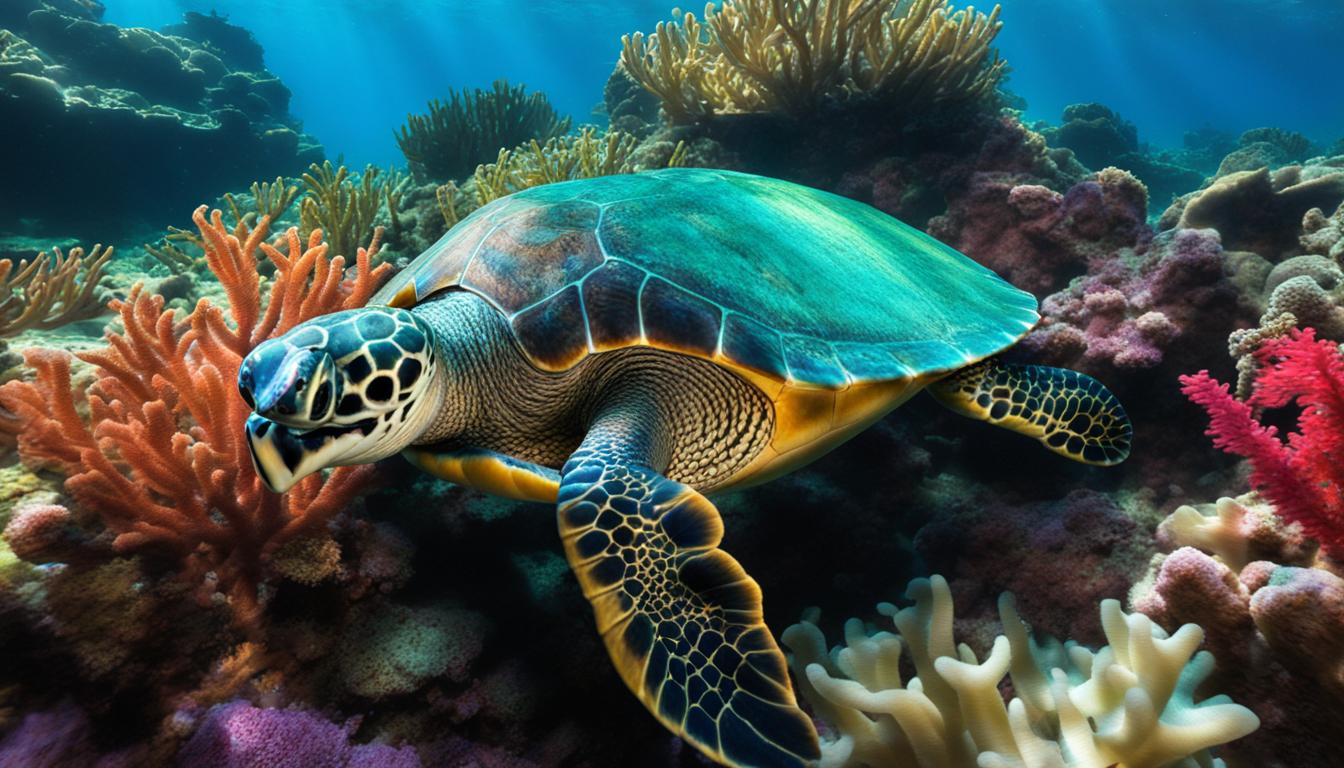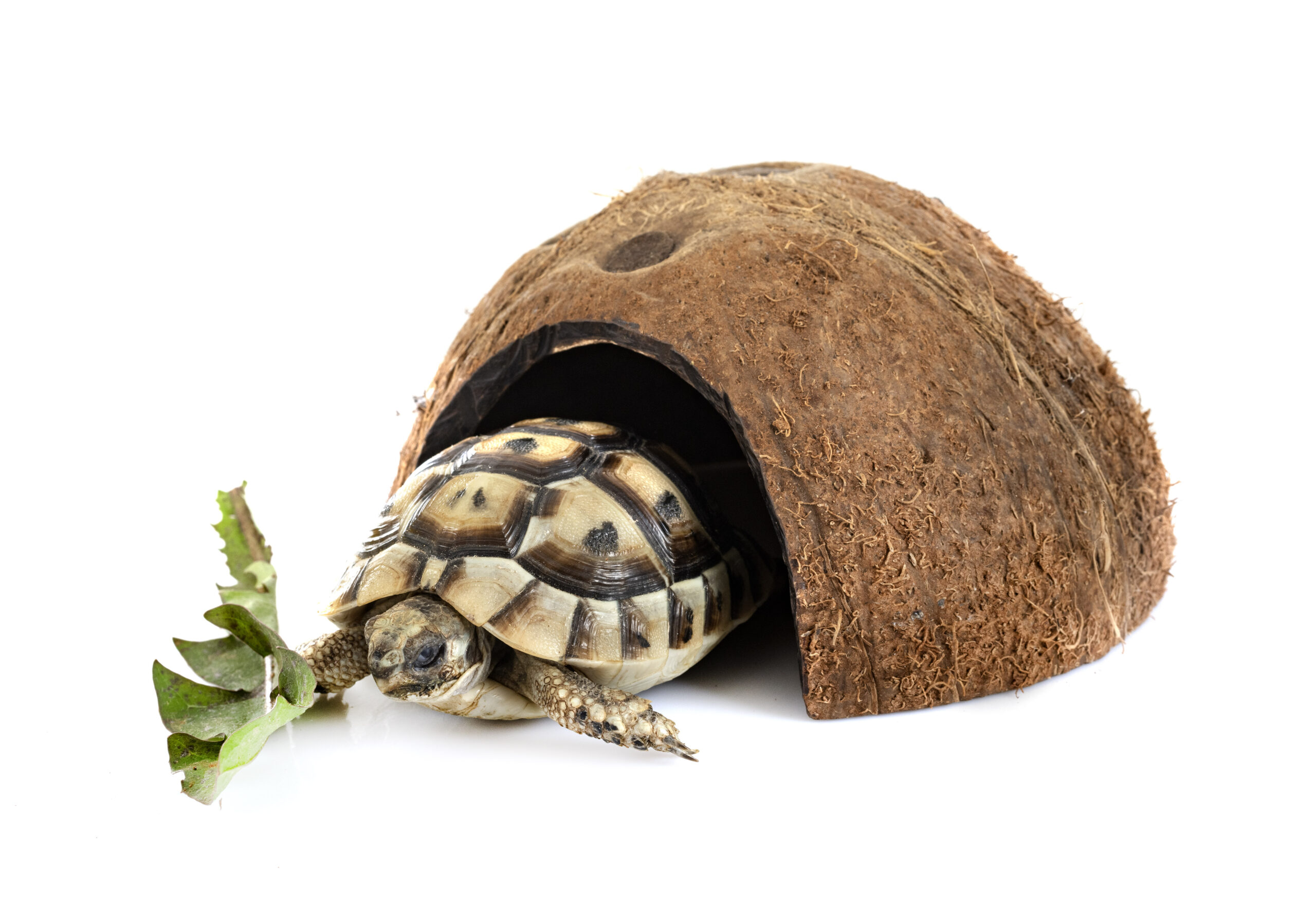Do Turtles Have Tails? Welcome to our in-depth exploration of turtle anatomy! In this article, we will delve into the intriguing world of turtle tails and uncover the secrets behind their unique structures. Have you ever wondered if turtles have tails? Well, the answer is a resounding yes! But did you know that the length, shape, and structure of these tails can vary significantly between different turtle species? Let’s dive in and discover the fascinating facts about turtle tails and their role in the lives of these remarkable creatures.
Key Takeaways:
- Turtles do have tails, and their length, shape, and structure can vary among different species.
- Turtle tails play crucial roles in swimming, navigation, and reproductive behaviors.
- Exploring turtle anatomy provides insights into their adaptations to marine habitats.
- Understanding turtle tails is essential for conservation efforts and the long-term survival of these magnificent creatures.
- Stay tuned as we unravel the mysteries of turtle tails and delve deeper into the world of turtle anatomy.
Sea Turtle Anatomy and Adaptations
Sea turtles are remarkable creatures with unique anatomy and specialized adaptations that allow them to thrive in marine environments. Their streamlined bodies and various physical features enable them to navigate the vast oceans and fulfill their essential ecological roles. Let’s explore some of the key aspects of sea turtle anatomy and adaptations.
The Carapace: A Shell of Protection
One of the most distinctive features of sea turtles is their shell, known as the carapace. The carapace serves multiple functions, providing both protection and buoyancy control. Made up of a fusion of bones and cartilage, the carapace shields the turtle’s vital organs from predators and external threats. Its shape and size vary among different species, with some having more streamlined shells for improved swimming efficiency, while others have thicker and more robust shells for enhanced defense.

Adaptations for Swimming and Navigation
Sea turtles have evolved specialized adaptations that enable them to maneuver through the water with grace and precision. Instead of walking limbs, they possess powerful flippers that are perfectly suited for propelling them forward. These flippers, along with their streamlined bodies, allow sea turtles to glide effortlessly through the ocean currents. Additionally, sea turtles have well-developed eyes that provide excellent underwater vision, helping them navigate and locate food sources and suitable nesting beaches. Their highly developed sense of smell further aids in finding their way across vast distances.
Head and Sensory Abilities
The heads of sea turtles house several critical features that contribute to their survival. These include their well-developed eyes, which have excellent visual acuity underwater. Sea turtles rely on their vision to navigate through complex habitats, locate food, and find potential mates. Their sense of smell is also highly refined, enabling them to detect chemical cues in the water to locate food and identify suitable nesting beaches. Combined with their other adaptations, such as their streamlined bodies and specialized flippers, sea turtles possess a remarkable suite of anatomical features that allow them to thrive in their oceanic habitats.
Understanding the anatomy and adaptations of sea turtles provides insights into their fascinating biology and highlights the importance of conservation efforts to protect these incredible creatures and their fragile marine ecosystems.
The Function of Sea Turtle Tails
Sea turtle tails, known as caudal appendages, serve a vital purpose in the survival of these magnificent creatures. These tails play a crucial role in swimming and maintaining balance underwater. They assist in steering through varying currents and executing intricate maneuvers. The caudal appendages also contribute to the reproductive behavior of sea turtles, with males using their tails to grasp onto females during mating. Additionally, female sea turtles rely on their tails to dig nesting burrows in the sand and lay their eggs. The versatility and importance of sea turtle tails make them a fascinating aspect of their anatomy.
Sea turtles are graceful swimmers, and their tails are essential for efficient propulsion through the water. The lateral oscillation of their tails allows them to generate forward thrust and achieve impressive speeds. By moving their tails from side to side, sea turtles can navigate through currents and rapidly change direction when necessary. This remarkable level of control enables them to thrive in their marine habitats and adapt to diverse environmental conditions.
“The caudal appendages of sea turtles are remarkable adaptations that contribute to their survival and reproductive success. From swimming and maneuvering in the water to the intricate courtship rituals, the functionality of these tails is truly impressive.”
Furthermore, the reproductive behavior of sea turtles heavily relies on their tails. During mating, male sea turtles use their tails to hold onto females, ensuring successful fertilization. This behavior not only facilitates reproduction but also gives males a competitive advantage in securing mating rights. On the other hand, female sea turtles use their tails to dig deep nesting burrows in the sand. These burrows provide a safe and protected environment for them to lay their eggs. The tails of sea turtles play an integral role in the continuation of their species, highlighting the significance of this unique adaptation.
Table: Sea Turtle Tails and Their Functions
| Sea Turtle Species | Tail Function |
|---|---|
| Green Sea Turtle | Aids in efficient long-distance migrations and grazing |
| Loggerhead Sea Turtle | Allows for efficient maneuvering in search of prey |
| Hawksbill Sea Turtle | Enables seamless navigation through coral reefs |
| Kemp’s Ridley Sea Turtle | Enables swift traversal of ocean currents |
| Leatherback Sea Turtle | Propels the turtle during deep dives |
Sea turtle tails are a remarkable adaptation that showcases the incredible diversity and functionality of these fascinating creatures. From swimming and navigation to reproduction, these tails play a crucial role in the survival and success of sea turtles in their marine environments. Understanding the functions and variations of sea turtle tails contributes to our knowledge of their biology and aids in the conservation efforts aimed at protecting these magnificent creatures for future generations.
Sea Turtle Species and Tail Variations
Sea turtles are a diverse group, with several species exhibiting unique characteristics and tail variations. These variations in tail length, shape, and structure are closely linked to their specific behaviors and habitats. Let’s take a closer look at some of the sea turtle species and their distinctive tail features:
Green Sea Turtle
The Green Sea Turtle has a moderate-length tail that aids in swift and graceful movements through the water. This tail variation allows them to navigate both open ocean and shallow coastal areas with ease. The Green Sea Turtle’s tail enables efficient long-distance migrations and grazing, making it well-suited to their herbivorous diet.
Loggerhead Sea Turtle
The Loggerhead Sea Turtle possesses a relatively short but robust tail that is ideal for efficient maneuvering in search of prey. This tail variation allows them to navigate various marine habitats, including seagrass beds and coral reefs. The Loggerhead Sea Turtle relies on its powerful tail to forage and consume a diet primarily consisting of hard-shelled invertebrates.
Hawksbill Sea Turtle
The Hawksbill Sea Turtle showcases a slightly elongated and slender tail, which enables easy navigation through narrow gaps and crevices in coral reefs. This tail variation allows them to feed on sponges, an important ecological role. The Hawksbill Sea Turtle’s specialized tail allows them to thrive in reef environments that other sea turtle species may find challenging to navigate.
Kemp’s Ridley Sea Turtle
The Kemp’s Ridley Sea Turtle exhibits a relatively short and thick tail that aids in swift traversal of ocean currents. This tail variation enables them to migrate across vast distances and forage in different areas. The Kemp’s Ridley Sea Turtle’s tail is well-suited to their opportunistic feeding habits, allowing them to adapt to changing food availability in oceanic environments.
Leatherback Sea Turtle
The Leatherback Sea Turtle possesses a longer and streamlined tail, which provides them with the necessary propulsion during deep dives. This tail variation allows them to dive to great depths in search of their favorite prey, jellyfish. The Leatherback Sea Turtle’s unique tail structure enables them to explore the depths of the ocean, making them the ultimate diving specialists among sea turtles.
| Sea Turtle Species | Tail Length | Tail Shape | Tail Structure |
|---|---|---|---|
| Green Sea Turtle | Moderate | N/A | Efficient for long-distance migrations and grazing |
| Loggerhead Sea Turtle | Relatively short but robust | N/A | Efficient for maneuvering in search of prey |
| Hawksbill Sea Turtle | Slightly elongated and slender | N/A | Allows easy navigation through coral reefs |
| Kemp’s Ridley Sea Turtle | Relatively short and thick | N/A | Swift traversal of ocean currents |
| Leatherback Sea Turtle | Longer and streamlined | N/A | Provides propulsion during deep dives |
These variations in sea turtle tail length, shape, and structure offer a glimpse into the fascinating adaptations of sea turtles to their marine environments. The diverse tails of sea turtles contribute to their survival, enabling them to navigate, forage, migrate, and reproduce successfully. Understanding the unique characteristics of sea turtle tails is crucial for their conservation and protection.
Tail Length, Shape, and Structure
The tails of sea turtles exhibit fascinating variations in length, shape, and structure, reflecting their unique adaptations to different environments and behaviors. These differences offer insights into the diverse ways sea turtles navigate, swim, and reproduce.
When it comes to tail length, sea turtle species display distinct characteristics. The Leatherback Sea Turtle boasts a longer and streamlined tail, which aids in propelling itself during deep dives. In contrast, the Hawksbill Sea Turtle possesses a slightly elongated and slender tail, allowing it to effortlessly navigate through intricate coral reefs. The tail length of each species is intricately suited to their specific needs and habitats.
| Tail Length | Tail Shape | Tail Structure | |
|---|---|---|---|
| Green Sea Turtle | Moderate | Tapered | Efficient for long-distance migrations and grazing. |
| Loggerhead Sea Turtle | Relatively short | Robust | Efficient maneuvering and searching for prey. |
| Hawksbill Sea Turtle | Slightly elongated | Slender | Seamless navigation through coral reefs. |
| Kemp’s Ridley Sea Turtle | Relatively short | Thick | Swift traversal of ocean currents. |
| Leatherback Sea Turtle | Longer and streamlined | N/A | Propulsion during deep dives. |
As for tail shape and structure, these characteristics are closely related to the specific behaviors of each sea turtle species. The Green Sea Turtle’s moderate tail, tapered in shape, allows efficient long-distance migrations and grazing. In contrast, the Loggerhead Sea Turtle possesses a relatively short but robust tail, which aids in efficient maneuvering and searching for prey.
“The diverse tail variations among sea turtle species are a testament to the remarkable adaptations these creatures have undergone to thrive in their diverse marine habitats.” – Marine Biologist Dr. Emily Anderson
Overall, the variations in tail length, shape, and structure among sea turtle species highlight the incredible diversity and adaptability of these marine creatures. Each tail is finely tuned to support specific behaviors and survival strategies, showcasing the intricate interplay between biology and evolutionary pressures.
The Purpose of Sea Turtle Tails
Sea turtle tails serve a crucial purpose in the survival and success of these marine creatures. One of their primary functions is swimming, as the tails provide propulsion through lateral oscillation. The oscillation of the tail allows sea turtles to navigate through various currents, ensuring they can reach their destinations with precision. By using their tails, sea turtles can steer through the water, making quick turns and executing intricate maneuvers to escape predators or catch prey.
In addition to swimming, sea turtle tails play a vital role in reproductive behavior. During mating, male sea turtles use their tails to grasp onto females, ensuring successful reproduction. This behavior allows them to secure their position and increase their chances of mating success. Furthermore, female sea turtles rely on their tails to dig nesting burrows in the sand and lay their eggs. The strong and agile tails of female sea turtles enable them to create a suitable environment for their offspring, ensuring their survival.
Sea turtle tails also contribute to the overall balance and control of these creatures underwater. The tails help maintain stability by counteracting the weight of the shell and providing additional support. This balance is crucial for sea turtles, especially when they are navigating complex environments such as coral reefs, where precise movements are necessary to avoid collisions and damage.

The purpose of sea turtle tails extends beyond mere locomotion and reproductive behavior. They are versatile and integral to the survival and success of these fascinating creatures, enabling them to navigate the vast ocean, find suitable nesting grounds, and fulfill their vital ecological roles.
Caudal Dimorphism in Sea Turtles
Caudal dimorphism refers to the distinct differences in tail morphology between male and female sea turtles. These differences are not merely cosmetic, but rather reflect the specific roles and strategies of each gender. Male sea turtles often possess larger and more robust tails, which they use in competitive interactions to establish dominance and secure mating rights. In contrast, female sea turtles have tails refined for buoyancy and navigation, supporting their ventures across vast oceanic distances and facilitating successful egg transport.
The sexual dimorphism observed in sea turtle tails is a result of evolutionary adaptation to their respective roles in reproduction. The larger size and increased muscularity of male tails enable them to engage in intense courtship behaviors and compete for mating opportunities. By contrast, female tails are optimized for navigating long migration routes, finding suitable nesting sites, and safely depositing their eggs in the sand.
| Gender | Tail Characteristics |
|---|---|
| Male | Larger and more robust tails for competitive interactions and securing mating rights |
| Female | Tails refined for buoyancy, navigation, and successful egg transport |
The unique tail differences between male and female sea turtles underscore the intricate interplay of biology and evolution in these incredible creatures. This caudal dimorphism has allowed sea turtles to adapt to their distinct reproductive strategies and ecological niches. By understanding the nuanced variations in tail morphology, we can gain deeper insights into the reproductive behaviors and ecological functions of sea turtles, ultimately contributing to their conservation and management.
DNA Methylation and TSD in Turtles
DNA methylation has emerged as a fascinating area of study in understanding the complex mechanisms underlying temperature-dependent sex determination (TSD) in turtles. TSD is a process where the ambient temperature during embryonic development influences the sexual fate of the offspring. Research suggests that differential DNA methylation plays a role in the transcriptional regulation of genes involved in gonadal differentiation in TSD turtles.
The turtle genome holds valuable insights into the interplay between epigenetic mechanisms and phenotypic plasticity. DNA methylation, as an epigenetic modification, can alter gene expression without affecting the underlying DNA sequence. By studying DNA methylation patterns in turtles, scientists aim to unravel the precise mechanisms by which temperature influences the development of male or female turtles.
“The investigation of DNA methylation in turtles provides a unique perspective on the intricate process of sexual development in reptiles,” says Dr. Jane Thompson, a leading researcher in turtle genetics. “Understanding the role of DNA methylation in TSD can help shed light on the broader evolutionary implications of this intriguing phenomenon.”
Further research in this field can contribute to our understanding of how environmental factors influence gene expression and development in diverse species. Exploring the association between DNA methylation and TSD in turtles can also have broader implications for understanding the mechanisms of sex determination and adaptation in other reptiles.
| Turtle Species | Tail Length | Tail Shape | Tail Structure |
|---|---|---|---|
| Green Sea Turtle | Moderate | Efficient long-distance migrations and grazing | Allows efficient long-distance migrations and grazing |
| Loggerhead Sea Turtle | Relatively short but robust | Efficient maneuvering in search of prey | Allows efficient maneuvering in search of prey |
| Hawksbill Sea Turtle | Slightly elongated and slender | Easy navigation through coral reefs | Allows easy navigation through coral reefs |
| Kemp’s Ridley Sea Turtle | Relatively short and thick | Swift traversal of ocean currents | Allows swift traversal of ocean currents |
| Leatherback Sea Turtle | Longer and streamlined | Propulsion during deep dives | Allows propulsion during deep dives |
Sea Turtle Conservation and Future Research
As sea turtle populations continue to decline worldwide, conservation efforts and future research become increasingly important in ensuring the survival of these magnificent creatures. The preservation of sea turtle habitats is crucial for their long-term well-being, as these habitats provide critical nesting grounds and foraging areas. By implementing effective conservation strategies and promoting habitat preservation, we can help protect sea turtles and their fragile ecosystems.
Research priorities in the field of sea turtle conservation include further investigation into the role of DNA methylation in temperature-dependent sex determination (TSD). Understanding the genetic and epigenetic mechanisms behind TSD can provide valuable insights into the reproductive biology of sea turtles and help inform conservation practices. Additionally, studying the impact of environmental contaminants on sea turtle populations is essential for developing effective mitigation strategies to reduce their harmful effects.
“Preserving sea turtle habitats and understanding their biology are crucial for their long-term survival.”
Education and public awareness are also vital components of sea turtle conservation. By promoting awareness about the importance of sea turtles and their habitats, we can inspire communities to take action and contribute to conservation efforts. Through outreach programs, initiatives, and partnerships with local communities, we can empower individuals to become environmental stewards and protectors of sea turtles.
| Research Priorities | Goals |
|---|---|
| Investigate DNA methylation in TSD turtles | Uncover genetic mechanisms underlying TSD |
| Study the impact of environmental contaminants | Develop mitigation strategies to protect sea turtles from harmful effects |
| Promote education and public awareness | Inspire individuals to become environmental stewards |
It is through these collective efforts, driven by research, conservation, and education, that we can work towards a future where sea turtles thrive in their natural habitats. By understanding the unique biology and challenges faced by sea turtles, we can develop effective strategies to protect and preserve these incredible creatures for generations to come.

Conclusion
In conclusion, sea turtle tails play a crucial role in their survival and success. These remarkable appendages are essential for swimming, navigation, and reproductive behavior. The diverse variations in tail length, shape, and structure among different sea turtle species reflect their unique adaptations to their marine habitats.
Furthermore, DNA methylation has emerged as a potential mechanism underlying temperature-dependent sex determination in turtles, adding a fascinating layer of complexity to their biology. Understanding the relationship between DNA methylation and the development of sea turtle embryos can provide valuable insights into their reproductive processes.
Conservation efforts focused on sea turtle habitats, along with ongoing research on their anatomy, genetics, and reproduction, are vital for their long-term survival. By unraveling the mysteries of sea turtle tails and their broader anatomy, we contribute to the preservation and conservation of these remarkable creatures for future generations to enjoy.
FAQ
Do turtles have tails?
Yes, all sea turtles have tails, but the length, shape, and structure of the tails vary among different species.
What is the function of sea turtle tails?
Sea turtle tails are essential for swimming, navigation, and maintaining balance underwater. They are also involved in reproductive behavior.
How do sea turtle tails vary among different species?
Different sea turtle species have unique characteristics and tail variations. The length, shape, and structure of their tails reflect their specific behaviors and habitats.
What is the purpose of sea turtle tails?
Sea turtle tails serve multiple essential functions, including swimming, propulsion, steering through currents, and reproductive behavior.
What is caudal dimorphism in sea turtles?
Caudal dimorphism refers to the differences between the tails of male and female sea turtles. These differences reflect distinct physical characteristics that mark the unique roles and strategies of each gender.
What is the role of DNA methylation in temperature-dependent sex determination in turtles?
DNA methylation has been linked to temperature-dependent sex determination in turtles, and it plays a role in the transcriptional regulation of genes involved in gonadal differentiation.
What are the conservation efforts for sea turtles?
The decreasing population sizes of sea turtles worldwide have spurred conservation efforts. Habitat preservation and conservation education are essential for the long-term survival of sea turtles.
What are the future research priorities for sea turtles?
Future research priorities include further investigation into the role of DNA methylation in temperature-dependent sex determination and the impact of environmental contaminants on sea turtle populations.







